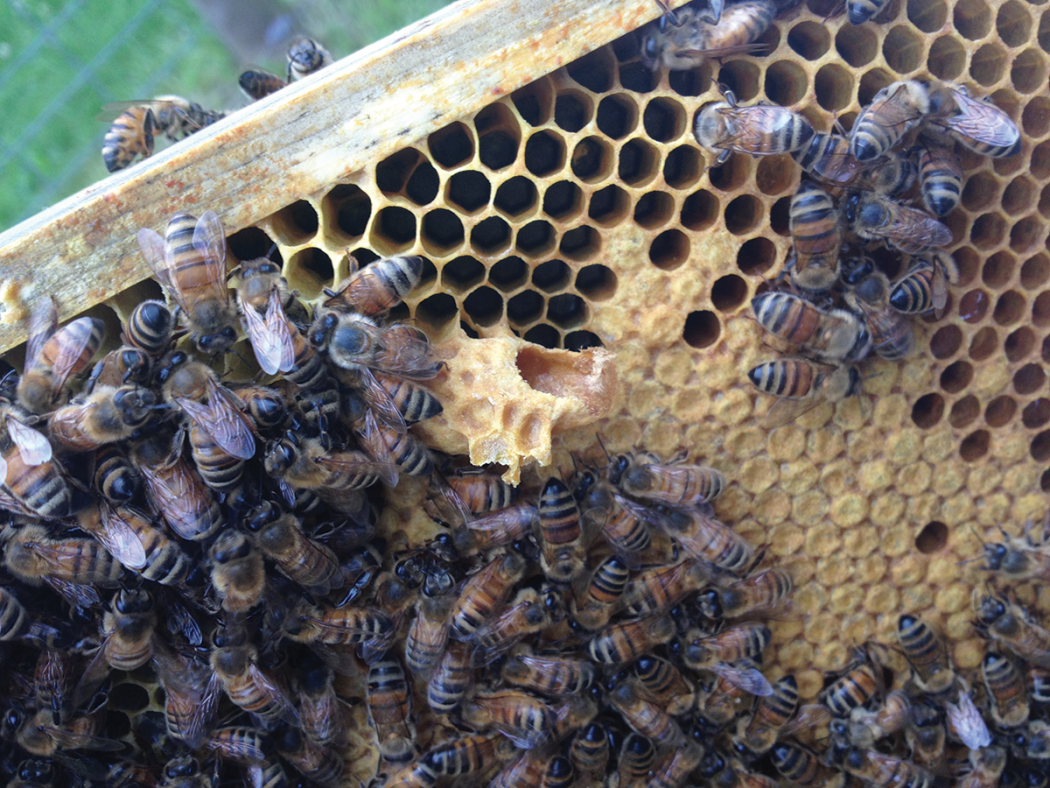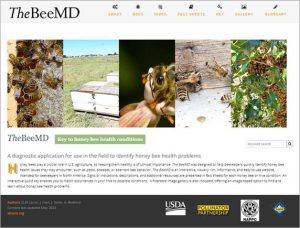The Hidden Signs Of Swarming
Stephen Repasky
In temperate areas, beekeepers look forward to many things in the Spring, such as the first pollen coming in from skunk cabbage, crocus, willow and snow drops, the beginning of a nectar flow when the maples bloom or the start of a new hive from a nuc or increase hive. These events herald the beginning of the annual cycle of reproduction for honey bee colonies that may reach its climax only a month or two later. Just as the flowers bloom in the spring, Honey bee colonies across the United States begin preparations for their annual colony reproductive event of swarming. It’s a natural phenomenon; a process that nearly all colonies go through, both managed and unmanaged. For many beekeepers, the thought of their colonies swarming brings mixed feelings of tension, worry and excitement. It causes “new-bees” to switch their concern from making sure their colony survived the winter to trying not to lose a colony and a potential honey harvest with it.
Losing a swarm may evoke feelings of failure from some beekeepers if it issues from your own apiary, but capturing a swarm also may bring on the feeling of great success. Catching a swarm is often viewed as a transition from a new beekeeper to one with more experience under the veil. Swarming is exciting and isn’t something to fear; instead, it is something to appreciate and respect. The behavior of a swarm of honey bees, and the colony’s preparations that lead up to a swarm issuing from the hive, give us a wonderful opportunity to study this marvel of Nature.
What is Swarming
Swarming is the colony’s way of reproducing at a larger level than the reproduction that takes place within the cells of wax comb. It is a process that healthy colonies go through to divide one colony into two or more independent units, as the season allows. It is asexual, meaning that the “reproduction” occurs by fission, where the colony divides roughly in half and the “new” colony is the swarm that leaves with the mother queen while the rest of the colony remains behind to raise a new queen and continue their existence. This process also provides a reduction or a break in the brood cycle, which also may aide in the reduction of the Varroa mite, a major pest to the Honey bee. It is important that beekeepers understand how to manage or deal with the swarming instinct of Honey bee colonies and in order to do that, they must understand the biological processes that take place within the hive.
What is that you see?
Throughout the process of swarming, beekeepers are most familiar with seeing the familiar peanut shaped queen cells along the lower one-third of the frames or locating the actual swarm in their bivouac on a tree limb or other temporary resting place. What we often miss out on are the signs within the colony that appear between the appearance of queen cells and the issuing of the primary swarm from the hive. These signs are often subtle but with some basic observations and understanding of Honey bee biology, they can tell the beekeeper a lot about what is happening or already has happened in their hive. Many beekeepers often react to seeing the queen cells by taking their hive tool and cutting them off or crushing them with the thinking that they will stop the swarming process and save their bees only to come back two weeks later to find more queen cells and likely a few thousand bees short! The swarming impulse in Honey bees is strong and once the process begins, it is very difficult to stop.
As a producer of queens with genetic traits I’d like to maintain I don’t mind the occasional swarm as they are putting some great genetics into areas outside of my outyards – thereby strengthening local genetics. What I am not a fan of is losing queens that I use for grafting, so my management is a little more intensive than the average small-scale beekeeper. I am in my hives at five to seven day intervals to make sure that I do not lose a swarm with a favorite queen along for the ride! I often say that I am a poor salesman when it comes to selling queens because I often get many calls during swarming season (May through June here in western Pennsylvania) from beekeepers saying that they believe their colony has swarmed and they do not have a queen and need to purchase one from me. This is where some basic observation and simple math will help you determine if you do indeed need a queen or if you might be jumping the gun just a little.
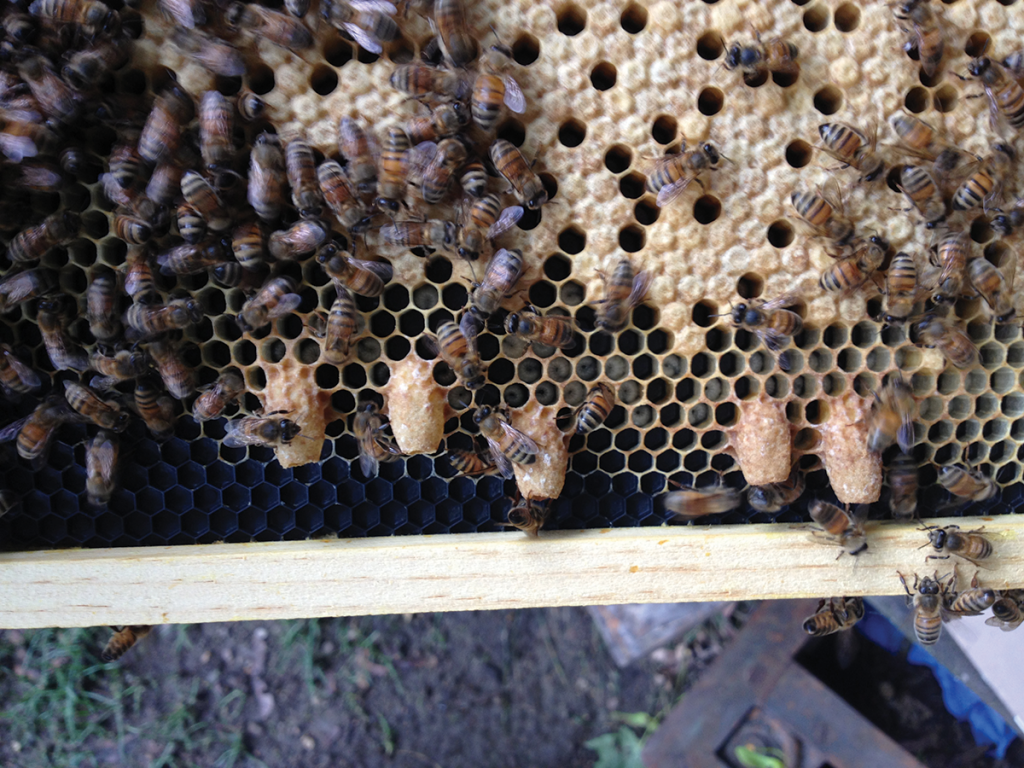
Uncapped queen cells.
First things first we must look at the age of the queen cells. As the swarm impulse strengthens, structures called queen cups begin to appear along the lower one-third of the frames. These structures are often called queen cups or play cups. They do not have an egg in them and can be removed by the beekeeper or the bees and rebuilt again days later seemingly at random, but they is no randomness when it comes to Honey bees. At this early stage a beekeeper should be aware but not overly concerned about immediate swarm departure. However, this can change rather quickly. As soon as an egg is deposited into the queen cup that structure now becomes a viable queen cell. Determining the age of that cell will assist you in determining at what stage the swarming impulse is in. An egg deposited into the queen cup (now officially a queen cell!) will be in an upright position. At day two the egg will begin to lean towards the bottom of the cell. By day three the egg is completely laying down and will soon hatch into a young larvae at which point nurse bees will feverishly begin to feed royal jelly to the larvae for the next four days as the larvae grows larger in size and acquires the classic “c-shaped” look that larvae have.

Only capped brood. No eggs or open brood. Empty cells in center filled with nectar.
At this point in the development of a swarm, the beekeeper should be more observant. Swarms will issue from a hive the day before or the day of capping of a queen cell ñ not all cells, just one and that, on average will occur on day seven or eight. Removing all of the queen cells at this point will only delay swarming for another week as the bees will quickly begin rearing more queen cells. Beekeepers choosing to use this technique as a method of swarm control should inspect their hives every five or six days to avoid the loss of a swarm. Even then we can miss a cell that is tucked into the edge of a frame or blended in too well and the swarm still issues despite our best try.
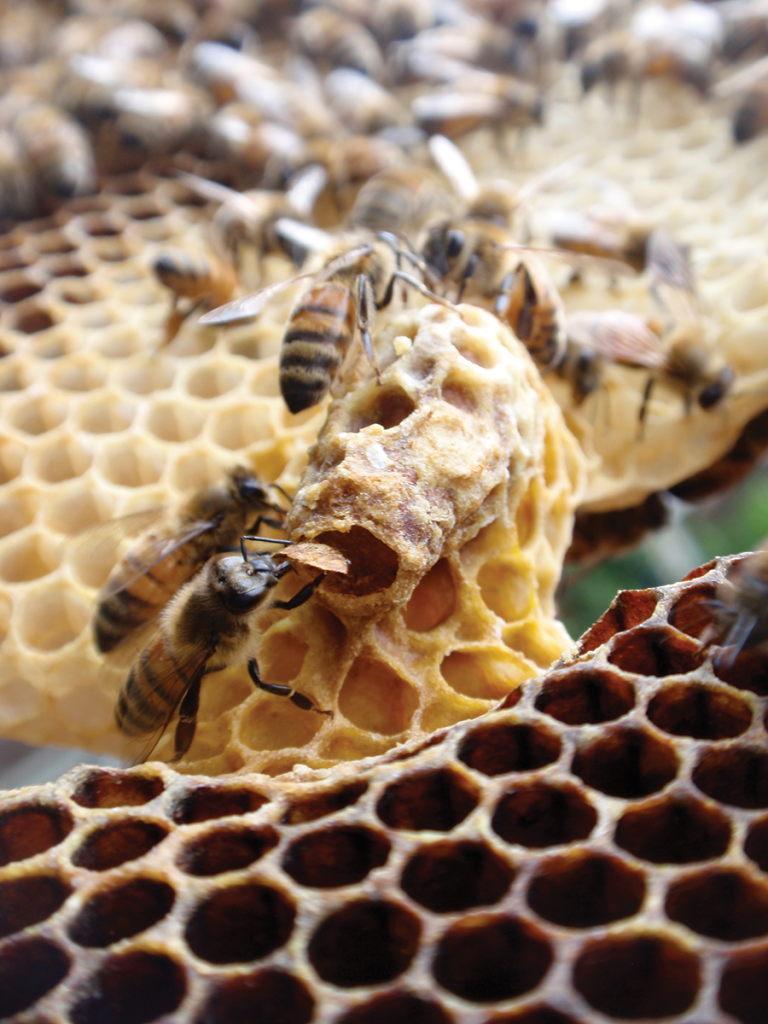
Queen cell with dead queen removed from hole inside. The cell was being capped.
You may find a colony that has swarmed and has queen cells of multiple ages. Once a queen cell is capped this assures the bees that they have an opportunity to replace the queen that issues with the swarm, ensuring that the parent hive will continue to thrive if the swarm is unable to make it through its first Winter to swarm itself in its second year.
If we remove all queen cells AFTER a colony has swarmed, and there are no eggs or young larvae for the bees to begin raising another queen, we have effectively caused that colony to become hopelessly queenless.
This is where beekeepers often fail at reading what the hive is telling us. Reading the condition of brood frames can give us an idea of when that colony has swarmed. The first step is to determine whether or not eggs are present. Though queens are run around by her workers to slim down and will lay less as they approach the day they issue from the hive, she does not always stop laying. Seeing eggs can mean that the colony has not swarmed (what age are the queen cells in?) or it can mean that they swarmed three days ago and the beekeeper is seeing what the queen had laid before she swarmed.
The presence of no eggs but open brood indicates that the colony swarmed approximately one to four days ago. You will see all stages of brood at this point. As the colony progresses and more time passes from when the swarm issued, more changes occur within the brood nest. The presence of only capped brood tells us that a colony swarmed at least eight days ago. Moving farther along in time, brood will begin to emerge and a common pattern can be seen. The oldest brood, located in the middle of a frame, has emerged and the bees are storing nectar in the cells where one would normally find eggs. As bees continue to emerge from their cells, the bees will fill the brood nest with additional nectar. We can be reasonably sure that the colony has swarmed at least 21 days ago (the time it takes for a worker to develop from egg to adult).
Using the development times of brood and queens and the basic observation of what the bees are doing in the hive can give us a lot of answers. However, we must also take into consideration colony equilibrium.
Colony Equilibrium
A colony in equilibrium is one that has a mated queen, many workers and drones. The process of swarming upsets this equilibrium by creating a situation where multiple queens (this includes cells, virgins and mated) are involved in a single colony. A study completed by David Gilley and David Tarpy [Apidologie 36 (2005) 461-474] describes three methods of queen elimination that can occur during the swarming process. Queen-queen duels occur when two newly emerged queens engage each other and “fight it out” to which an end result MAY end in one queen wounding or killing the other queen. A second method is called pre-emergence destruction. In this scenario, where there are multiple queen cells of similar ages are destroyed by a recently emerged virgin queen. Shortly after emerging, the virgin queen will go to the cells of her sister queens and eliminate them by stinging. Once they are eliminated, the workers will chew a large hole n the side of the cells and remove the now deceased virgin queen. The third method of queen elimination is called secondary swarm departure. Here, a week after the primary swarm has already issued from the hive, the now fully developed queen cells emerge. Secondary swarms will issue from a hive often leaving with multiple virgin queens. I have found as many as 12 virgin queens in one swarm and have heard of more than that, but often finding two to four virgin queens is common. Keep in mind that the size of the colony as well as colony equilibrium has an influence on how many times a colony will swarm. Leaving too many queen cells in a hive after a colony has swarmed once can result in a colony swarming two or three times or more. This often surprises newer beekeepers when they catch one swarm from their backyard hive and then a week to two weeks later catch another swarm from the same hive ñ this is because a thorough inspection was likely not completed and additional queen cells were left behind with the thought that a colony swarms once and then becomes queen right from the cells left behind. If you decide to remove queen cells ñ leave two cells behind so that you can be assured that there is an opportunity for the hive to become queen-right. The other cells can be used to create splits from hives that are on the verge of swarming or on hives that just aren’t producing. Dr. Larry Connorís Increase Essentials is a great source of information on using queen cells to make up nucs and splits in your own beeyard.
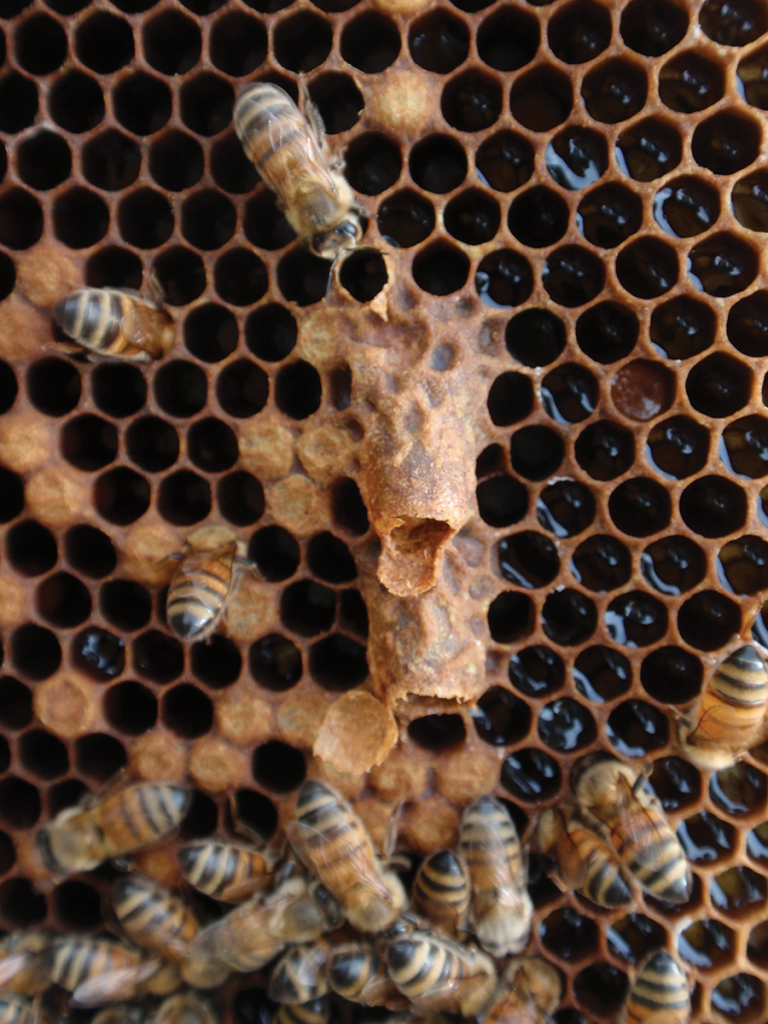
Multiple emerged virgin queen cells.
Once everything settles down, it can take up to three weeks after a colony issues its last swarm to become queen-right, which may be four weeks after the primary swarm has left the hive. This timeline often makes beekeepers antsy and is where I become a bad salesman! I usually begin fielding calls at the two-week mark after a colony has swarmed from beekeepers looking for replacement queens. Explaining colony equilibrium and swarm behavior results in a call back a week or two later with an excited beekeeper on the other end of the phone stating that they inspected their hive and that eggs and queen were found.
Stephen Repasky, author of Swarm Essentials, is a queen producer and EAS Master Beekeeper in Pittsburgh, PA. He can be reached at www.meadowsweetbees.com.




